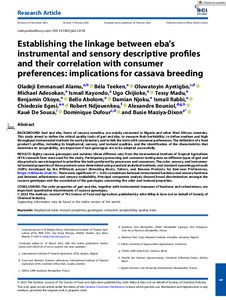| dc.contributor.author | Alamu, E.O. |
| dc.contributor.author | Teeken, B. |
| dc.contributor.author | Ayetigbo, O. |
| dc.contributor.author | Adesokan, M. |
| dc.contributor.author | Kayondo, S.I. |
| dc.contributor.author | Chijioke, U. |
| dc.contributor.author | Madu, T. |
| dc.contributor.author | Okoye, B. |
| dc.contributor.author | Bello, A.A. |
| dc.contributor.author | Njoku, D. |
| dc.contributor.author | Rabbi, I.Y. |
| dc.contributor.author | Egesi, C. |
| dc.contributor.author | Ndjouenkeu, R. |
| dc.contributor.author | Bouniol, A. |
| dc.contributor.author | de Sousa, K. |
| dc.contributor.author | Dufour, D. |
| dc.contributor.author | Maziya-Dixon, B. |
| dc.date.accessioned | 2023-03-07T08:53:15Z |
| dc.date.available | 2023-03-07T08:53:15Z |
| dc.date.issued | 2023-02-22 |
| dc.identifier.citation | Alamu, E.O., Teeken, B., Ayetigbo, O., Adesokan, M., Kayondo, I., Chijioke, U., ... & Maziya‐Dixon, B. (2023). Establishing the linkage between Eba's instrumental and sensory descriptive profiles and their correlation with consumer preferences: implications for cassava breeding. Journal of the Science of Food and Agriculture, 1-28. |
| dc.identifier.issn | 0022-5142 |
| dc.identifier.uri | https://hdl.handle.net/20.500.12478/8080 |
| dc.description.abstract | Background Gari and Eba (cassava semolina) is mainly consumed in Nigeria and other West African countries. Defining the food product profile (biophysical, sensory, and textural qualities) that drives its acceptability, and integrating the component traits into breeding programs, are critical for the better adoption of new genotypes. This study aimed to define the Gari and Eba critical quality traits, define medium and high throughput instrumental methods for use by breeders, measure their respective heritabilities, and link the traits with consumer preference. Results A total of 80 cassava genotypes and varieties (3 different sets) from the International Institute of Tropical Agriculture (IITA) research farm were used for the study. Participatory processing and consumer testing data on different types of Gari and Eba products were integrated to determine the prioritization of the preferred traits by processors and consumers. The color, sensory, and instrumental textural properties of Gari and Eba were determined using standard analytical methods, and standard operating protocols (SOPs) developed by the RTBfoods project (Breeding Roots, Tubers, and Banana products for end-user preferences: https://rtbfoods.cirad.fr). There were significant (p<0.05) correlations between instrumental hardness and sensory hardness and between adhesiveness and sensory moldability. The Principal Component Analysis shows broad discrimination amongst the cassava genotypes and the association of the genotypes concerning the color and textural properties. Conclusions The color properties of Gari and Eba are the essential indicators of quantitative discriminants of cassava genotypes. Instrumental measures of hardness and cohesiveness were the most discriminant and vital attributes relevant to consumer perception of Eba. |
| dc.description.sponsorship | Bill & Melinda Gates Foundation |
| dc.format.extent | 1-28 |
| dc.language.iso | en |
| dc.subject | Cassava |
| dc.subject | Texture |
| dc.subject | Properties |
| dc.subject | Genotypes |
| dc.subject | Consumers |
| dc.subject | Acceptability |
| dc.title | Establishing the linkage between Eba’s instrumental and sensory descriptive profiles and their correlation with consumer preferences: implications for cassava breeding |
| dc.type | Journal Article |
| cg.contributor.crp | Agriculture for Nutrition and Health |
| cg.contributor.crp | Maize |
| cg.contributor.crp | Roots, Tubers and Bananas |
| cg.contributor.affiliation | International Institute of Tropical Agriculture |
| cg.contributor.affiliation | Centre de Coopération Internationale en Recherche Agronomique pour le Développement |
| cg.contributor.affiliation | Universite de Montpellier |
| cg.contributor.affiliation | National Root Crops Research Institute, Nigeria |
| cg.contributor.affiliation | University of Ngaoundere |
| cg.contributor.affiliation | Universite d’Abomey-Calavi |
| cg.contributor.affiliation | Inland Norway University of Applied Sciences |
| cg.contributor.affiliation | Bioversity International |
| cg.coverage.region | Africa |
| cg.coverage.region | West Africa |
| cg.coverage.country | Nigeria |
| cg.coverage.hub | Southern Africa Hub |
| cg.coverage.hub | Headquarters and Western Africa Hub |
| cg.researchtheme | Biotech and Plant Breeding |
| cg.researchtheme | Nutrition and Human Health |
| cg.identifier.bibtexciteid | ALAMU:2023 |
| cg.isijournal | ISI Journal |
| cg.authorship.types | CGIAR and developing country institute |
| cg.iitasubject | Agronomy |
| cg.iitasubject | Cassava |
| cg.iitasubject | Food Security |
| cg.iitasubject | Livelihoods |
| cg.iitasubject | Nutrition |
| cg.iitasubject | Value Chains |
| cg.journal | Journal of the Science of Food and Agriculture |
| cg.notes | Published online: 22 Feb 2023; Open access Article |
| cg.accessibilitystatus | Open Access |
| cg.reviewstatus | Peer Review |
| cg.usagerightslicense | Copyrighted; all rights reserved |
| cg.targetaudience | Scientists |
| cg.identifier.doi | https://doi.org/10.1002/jsfa.12518 |
| cg.iitaauthor.identifier | Alamu Emmanuel Oladeji: 0000-0001-6263-1359 |
| cg.iitaauthor.identifier | Béla Teeken: 0000-0002-3150-1532 |
| cg.iitaauthor.identifier | Michael Adesokan: 0000-0002-1361-6408 |
| cg.iitaauthor.identifier | Kayondo Siraj Ismail: 0000-0002-3212-5727 |
| cg.iitaauthor.identifier | Bello Abolore: 0000-0002-8871-6163 |
| cg.iitaauthor.identifier | Ismail Rabbi: 0000-0001-9966-2941 |
| cg.iitaauthor.identifier | Chiedozie Egesi: 0000-0002-9063-2727 |
| cg.iitaauthor.identifier | Busie Maziya-Dixon: 0000-0003-2014-2201 |

